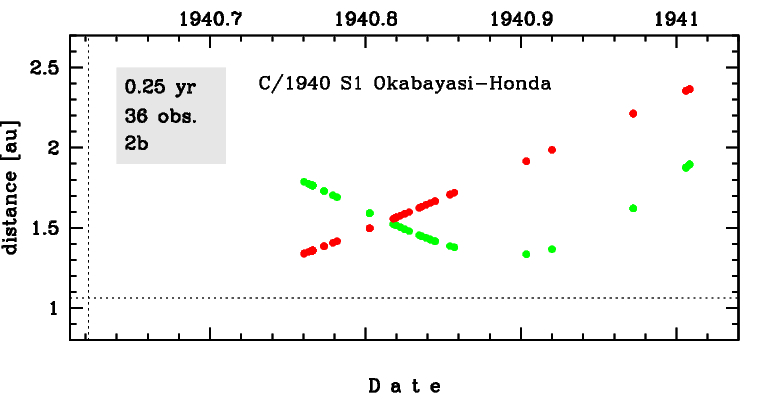C/1940 S1 Okabayashi-Honda
more info
Comet C/1940 S1 was discovered on 30 September 1940 by Shigeki Okabayashi (Kurashiki Observatory, Japan), and indeendently, on 3 October by Minoru Honda (Zodiakal Light Observatory, Seto, Japan).At the moment of discovery, this comet was is 1.5 month after perihelion passage, and it was last seen on 3 January 1941. [Kronk, Cometography: Volume 4].
This comet made its closest approach to the Earth on 30 May 1940 (1.194 au), that is 4 months before its discovery.
Solution given here is based on data spanning over 0.249 yr in a range of heliocentric distances from 1.35 au to 2.38 au.
This comet suffers moderate planetary perturbations during its passage through the planetary system that lead to escape the comet from the planetary zone on a hyperbolic orbit (see future barycentric orbit).
More details in Królikowska et al. 2014.
This comet made its closest approach to the Earth on 30 May 1940 (1.194 au), that is 4 months before its discovery.
Solution given here is based on data spanning over 0.249 yr in a range of heliocentric distances from 1.35 au to 2.38 au.
This comet suffers moderate planetary perturbations during its passage through the planetary system that lead to escape the comet from the planetary zone on a hyperbolic orbit (see future barycentric orbit).
More details in Królikowska et al. 2014.
| solution description | ||
|---|---|---|
| number of observations | 36 | |
| data interval | 1940 10 04 – 1941 01 03 | |
| data type | observed only after perihelion (POST) | |
| data arc selection | entire data set (STD) | |
| range of heliocentric distances | 1.34 au – 2.37au | |
| detectability of NG effects in the comet's motion | NG effects not determinable | |
| type of model of motion | GR - gravitational orbit | |
| data weighting | YES | |
| number of residuals | 61 | |
| RMS [arcseconds] | 2.67 | |
| orbit quality class | 2b | |
| next orbit statistics, both Galactic and stellar perturbations were taken into account | ||
|---|---|---|
| no. of returning VCs in the swarm | 225 | |
| no. of escaping VCs in the swarm | 4776 | |
| no. of hyperbolas among escaping VCs in the swarm | 4749 | * |
| next reciprocal semi-major axis [10-6 au-1] | -1,257.78 – -699.64 – -165.29 | |
| next perihelion distance [au] | 1.07 – 1.11 – 1.17 | |
| next aphelion distance [103 au] | 5 – 17 – 130 | |
| synchronous stop epoch [Myr] | 0.402 | S |
| percentage of VCs with qnext < 10 | 100 | |
| next_g orbit statistics, here only the Galactic tide has been included | ||
|---|---|---|
| no. of returning VCs in the swarm | 226 | |
| no. of escaping VCs in the swarm | 4775 | |
| no. of hyperbolas among escaping VCs in the swarm | 4749 | * |
| next reciprocal semi-major axis [10-6 au-1] | -1,257.68 – -699.57 – -165.25 | |
| next perihelion distance [au] | 1.07 – 1.1 – 1.15 | |
| next aphelion distance [103 au] | 5 – 17 – 130 | |
| synchronous stop epoch [Myr] | 0.398 | S |
| percentage of VCs with qnext < 10 | 100 | |
